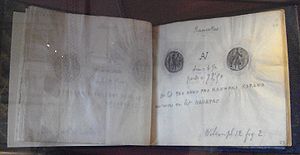- Claude Auguste Court
-
 Book of rubbings of Kushan coins, by Claude Auguste Court, between 1827-1844. British Museum.
Book of rubbings of Kushan coins, by Claude Auguste Court, between 1827-1844. British Museum.
Claude Auguste Court was a French soldier and mercenary.
He was hired by Maharaja Ranjit Singh of Punjab in 1827 to organize and train the artillery. He was promoted to the rank of General, and served as one of the leading European officers in the Khalsa.
Contents
Early life
Court was born at Saint Cezaire, France, on 24 September 1793.[1] He was educated at the Ecole Polytechnique in Paris[2]
Military career in French army
In 1813, he joined the French army. After Napoleon's defeat at Waterloo in 1815 he was dismissed from service. He left France in 1818 for Baghdad and joined the Persian forces which were trained at Kermanshah by a handful of ex-officers of Napoleon's army including Ventura. While in Persia, he met another Neapolitan adventurer Avitabile and together they travelled on to Lahore reaching there in early 1827.[3]
Military services with Maharaja Ranjit Singh of Punjab
Maharaja Ranjit Singh gave Court employment in the artillery befitting his talents and scientific attainments. Court was responsible for the training of artillerymen, the organization of batteries and the establishment of arsenals and magazines on European lines. The Maharaja had his own foundries for casting guns and for the manufacture of shells. Court supervised these in collaboration with Sardar Lahina Singh Majithia.
When Court produced the first shell at the Lahore foundry, the Maharaja bestowed upon him a prize of Rs 30,000, and when he produced the fuse, he was rewarded with an award of Rs 5,000. Court received a salary of Rs 2,500 per month, besides ajagir.
Expedition and battles
He took part in the expedition of Peshawar (1834) and the battle of Jamrud (1837). He was promoted to general in 1836.
Role during struggle for succession of Ranjit Singh
Claude Auguste Court continued to serve the State after the death of Maharaja Ranjit Singh. After the death of Kanvar Nau Nihal Singh on 5 November 1840, Court along with Ventura sided with Sher Singh who was installed as Maharaja, with their help in investing the Fort of Lahore, on 20 January 1841.
Later life and death
After Maharaja Sher Singh's assassination in September 1843, he fled to Firozpur, in British territory, and, ultimately securing his discharge from the Sikh army, proceeded with his Punjabi wife and the children to France in 1844. He purchased an estate in the countryside and a residence in the city of Paris where he lived until his death in 1880.[4]
Interest in coin collection
Court was one of the first Europeans to become interested in the coins of South Asia, which he collected from 1829. All trace of the collection vanished until 1994, however, when three albums came to light in an English book sale. They contain 627 rubbings, allowing many of Court's coins to be identified. These had been bought by Alexander Cunningham and entered the British Museum with his collection in 1888–94. Cunningham may also have owned the albums.[5]
See also
- France-Asia relations
- Fauj-i-Khas
- Ranjit Singh
- Paolo Avitabile
References
- ^ http://www.allaboutsikhs.com/british/court-claude-auguste.html
- ^ http://books.google.co.in/books?id=FIIQhuAOGaIC&pg=PA339&lpg=PA339&dq=Claude+Auguste+Court&source=bl&ots=-0DJDJ1WrV&sig=xT5eWJ-00enr8a28gadj-NQM-_I&hl=en&ei=AN_ESqvZKYKN8AbXkelJ&sa=X&oi=book_result&ct=result&resnum=10&ved=0CCwQ6AEwCQ#v=onepage&q=Claude%20Auguste%20Court&f=false
- ^ http://www.allaboutsikhs.com/british/court-claude-auguste.html
- ^ http://www.thesikhencyclopedia.com/european-adventurers-scholars-and-officials/court-claude-auguste.html?directory=1
- ^ http://www.britishmuseum.org/explore/highlights/highlight_objects/cm/g/general_claude-auguste_courts.aspx
Categories:- Mercenaries
- History of Sikhism
- History of Punjab
- Military history of India
Wikimedia Foundation. 2010.
